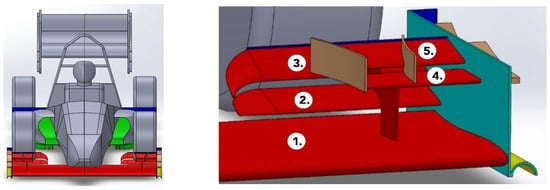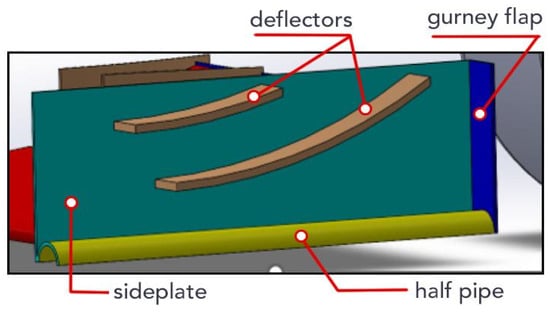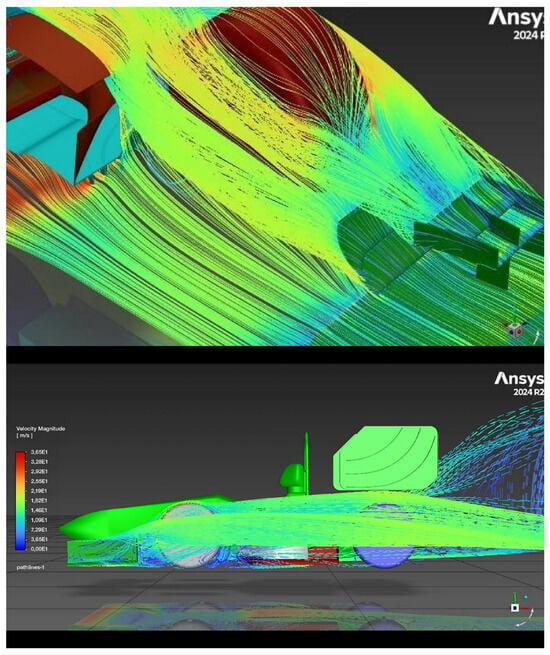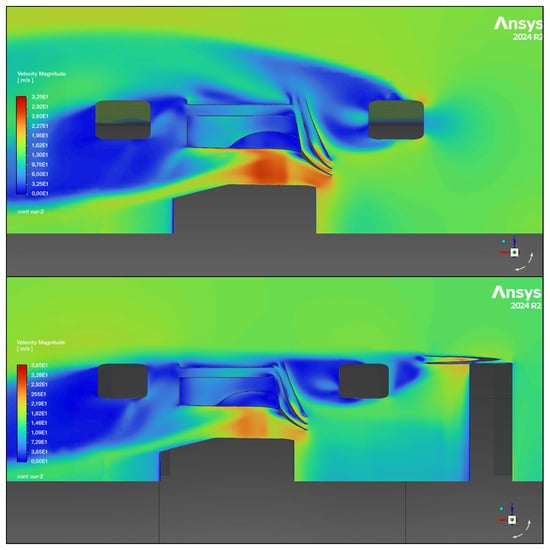Abstract
One of the key elements in the aerodynamic balance of a race car is the front wing, which is responsible for generating downforce to enhance grip. This article aims to investigate the change in downforce on a Formula Student racecar with a newly mounted front wing and aerodynamic elements at different angles of attack by means of Computational Fluid Dynamics (CFD). In addition, the effect of the front wing on the position of the center of pressure was also investigated, which highly influences the steering stability of the car. The study proved that by applying the front wing, together with additional aerodynamic elements, the downforce increases by 38%, while the center of pressure moves closer to the front axes by approximately 30% (compared to when there is no wing on the car), which results in an understeered but stable controllability.
1. Introduction
The aerodynamic development of racing cars has played an important role in motorsports since the 1960s. Initially, especially in Formula 1, theories were taken from aeronautics, and they started to use different profiles on cars [,]. The primary aim of such developments is to reach higher curve speed and the best possible balance for different racetrack characteristics.
These characteristics can also be enhanced by the mass distribution and the wing design of the racing car []. Regarding the mass distribution, it is important to note that for internal combustion and electric designs, different aerodynamic elements are recommended due to the different mass distribution [].
Regarding the wing design, the key element of the aerodynamic balance of a racing car is the front wing, whose primary function is to generate downforce, increasing the normal force on the wheels and increasing the grip of the front wheels [,,].
In connection with this, the coefficient of friction of the tires (μ) also determines the lateral acceleration of the car [,,]. By increasing the normal force acting on the wheels, the potential lateral acceleration is enhanced, allowing significantly higher cornering speed and improved braking performance.
Moreover, the front wing significantly affects the floor pan of the car (venturi tunnel), the rear wing, the diffuser, and the efficiency of the engine cooling system. With proper design, the front wing can significantly reduce overall aerodynamic drag while maximizing downforce, contributing to optimal vehicle performance.
An often overlooked yet crucial aspect in front wing design is the significant turbulence generated by the front wheels themselves. This turbulent airflow can substantially reduce the aerodynamic efficiency of the front wing. For this reason, it is important that the front wing have additional elements that generate various vortex flows, so they help direct airflow either inboard (“in-wash”) or outboard (“out-wash”) relative to the front tires, effectively reducing the drag effect.
Finally, yet importantly, when designing the front wing, changing the angle of the wing profile has a major impact on the balance of the car. If the camber angle is increased, so are the downforce and the drag as well. It is essential to note that adjusting downforce levels also shifts the car’s center of pressure (CoP) relative to its center of mass (CoM). When the CoP moves ahead of the CoM, due to a steeper wing angle, the car tends to become oversteered, which means the rear loses grip more easily, and less steering input is needed at higher lateral accelerations to maintain the cornering line. Conversely, if the CoP shifts behind the CoM, the vehicle becomes understeered, requiring more steering input to stay on the intended path as lateral acceleration increases. These balance characteristics are highly dependent on the layout of the racetrack and the driving style of the driver, making fine-tuning the front wing angle a key aspect of setup strategy.
The purpose of this article is twofold. Firstly, a front wing package should be created, which can achieve a significant (at least 15%) increase in downforce for our Formula Student race car.
Secondly, the current CoP position, which lies at approximately 88% relative to the front axle, is intended to be reduced by at least 20%. This adjustment is designed to retain a degree of understeer, ensuring the car remains stable and predictable. While the vehicle will still exhibit understeering characteristics, this change enhances the confidence of the driver and consistency, particularly during high-speed cornering and transitional maneuvers.
2. Materials and Methods
2.1. Design Conditions
The front wing is to be designed for a tube-frame racing car; therefore, it must meet the following conditions:
- The Fl/Fd ratio in the design should be at least 3.5;
- The minimum downforce at 54 km/h must be at least 125 N (this is the maximum speed of this type of Formula Student race car);
- The construction should be easy to manufacture, and it should be as lightweight as possible;
- It should have elements that reduce turbulence due to the size of the wheel and help the efficiency of the venturi tunnel in the middle of the car;
- The CoP should be closer to the rear axle.
2.2. Selection of Wing Profile
During the front wing design process, three potential configurations were initially considered. Two of these designs featured dual main profiles, with multiple elements shaped along curved guidelines, and included several additional flow control components (Figure 1).

Figure 1.
Elements of the front wing.
However, despite their aerodynamic potential, these complex designs were ultimately ruled out due to the significantly higher design time, increased manufacturing complexity, and greater production costs.
The marginal performance gains did not justify the additional effort and resources required for their implementation at this stage of development.
For the aerodynamic base concept, the third design option was selected, which consisted of a three-element wing configuration, complemented by additional flow deflector profiles (see Figure 1).
To simplify manufacturing, the selected airfoil profile is designed to serve dual functions—it can be used either as a main element or as a secondary element. The main profile refers to the component positioned closest to the tail of the wing, typically featuring the largest chord length, and plays a primary role in determining the aerodynamic behavior of the wing system assembly.
For the profile selection the Airfoil Tools database was used [,], where a profile with a high Cl/Cd ratio (>3.5) (Cl—lift coefficient, Cd—drag coefficient) was chosen. This profile is optimized for ground effect and performs well in the low Reynolds number range. To select, the Reynolds number had to be determined with regard to the average speed of the car (50 km/h) and the temperature of the air (20 °C) and asphalt (30 °C) during the spring season:
Taking into account the above yielded value, the FX60-100 10.0% smoothed profile was chosen as the main profile. The height of the profile can be 40–60 mm from the ground [], so the chord length was chosen to be 400 mm to ensure that our h/c ratio (height/chord) is between 0.1 and 0.3 [] and to maximize the ground effect []. This profile works well in environments with a Reynolds number of 105–106.
NACA 4412 was chosen as an additional profile, as it handles flow separation well and can be used at higher angles of attack, and its shape makes it easier to manufacture. The chord length of all NACA 4412 elements is the same [,,,].
2.3. Design of Aerodynamic End Plate and the Gurney Flap
The function of a is to prevent high pressure-air from forming at the top of the profiles from passing underneath the next profiles, where a low-pressure zone is formed. These end plates separate these two zones so that the wing operates more efficiently.
End plates were designed at the edges of wings in order to decrease the arising wing-tip eddies (see Figure 2). It must be mentioned that the downforce also depends on the geometry of these plates, namely on the so-called wing aspect ratio (shortly AR). This parameter is defined as the ratio of the wing length to the wing width. By increasing AR, the theoretical maximum Cl can be increased as well.

Figure 2.
Front wing elements.
Additional flow control elements have been designed to increase the efficiency of the designed end plate. At the bottom of the end plate is a vortex-generating half-pipe (Figure 3, highlighted in yellow), which is used to control the flow in front of the wheel and to isolate the venturi tunnel behind. At the end of the half-tube, a Gurney flap [,,] directs the outward flow of air from under the wing. The turbulence from the flaps is reduced by two additional baffles [,,] on the end plate.

Figure 3.
Structure of the mesh element.
2.4. Design of Baffles and Their Profiles
In Figure 1, the design of wing elements 2 and 3 has been designed to maximize the airflow upward from under the main airfoil (Figure 1).
The gaps and overlaps between the elements were designed to help delay flow separation. Ensuring the correct angle of upward flow is important to reduce wheel drag, so they are generally spaced between 3% and 5% of the chord length. Their exact size will be determined based on simulation results in the next subsection [].
Additional auxiliary wings were also designed for these wing elements to reduce the formation of eddy currents at the end of the wing element and to avoid the need for an end plate to close the airfoil, further reducing the drag of the entire front wing.
In Figure 1, wing elements 4 and 5 were integrated into the plate to divert as much air as possible above the wheel. Furthermore, these elements also serve as supports for two additional deflection elements. One baffle helps to direct the airflow outwards, while the other directs the airflow inwards, further increasing cooling performance.
2.5. Computational Fluid Dynamics Simulation
To investigate the efficiency of the wing, flow simulations were performed to determine the downforce (Fl) and drag force (Fd).
In the simulations, a flow velocity of 15 m/s was defined around the car (the average speed of the car on the racetrack), while a constant speed (15 m/s) was applied on the ground, while wheel rotation was not taken into account.
The k-ε model was chosen as the turbulence model. Octagonal elements were applied to create an unstructured mesh, with 8.2 million elements (local element size 0.1–8 mm). A mesh independence test was carried out, where 7.7 million, 8.2 million, and 9.4 million elements were investigated, respectively. Since only a 0.078% difference was found between the last two mesh configurations, 8.2 million was applied further on.
3. Results
3.1. Numerical Results on Lift Force
As a result of CFD simulations, downforces for the main airfoil (Figure 1) and the other airfoil elements (Figure 1) were determined.
From these results, the lift coefficient value of the airfoils for the race car can be determined. The difference between the Cl value for the airfoil derived from the database [,] and the Cl value calculated by CFD simulation is due to the fact that the airfoil derived from the database is located in a flow field by itself, away from the ground.
Numerical Cl values were used to demonstrate the extent to which the proposed aerodynamic configuration can increase Cl.
To determine Cl, we need the lifting force (Fl—from CFD simulation), the density of the flowing medium (ρ), the flow velocity (), and the surface area (A).
From the obtained results, it can be seen that the proposed front wing design (together with the main profiles) increases the magnitude of the downforce (by increasing Cl) by a large amount. As shown in Table 1, the value of Cl is more than doubled (244% difference in Cl value).

Table 1.
Comparison of analytical and numerical results.
Profiles designed alongside the main profile, when considered on their own, increase the real Cl value of the airfoil profile by a small amount. However, when they are used as a system, they can develop a suitable flow, which can significantly increase the Cl coefficient (Table 1). If the Cl value near ground level exceeds that in the Airfoil Tool database, it indicates that the simulations are progressing correctly.
In Figure 1, the auxiliary wings at the ends of wing elements 2 and 3 were designed in a way that the airflow would divert the low-pressure air behind the front wheel and away from the side box. Achieving this feature was a very important objective since at the beginning of the design phase it was not yet clear what propulsion system the race car would be equipped with (internal combustion or electric motor).
When determining the angle of attack (α), it was necessary to take into account that the upward airflow should not affect the operation of the rear wing in a negative direction. As shown on the right in Figure 4, the streamlines from the wing are lower than the rear wing end plate; therefore, they do not negatively affect the operation of the rear wing.

Figure 4.
Streamline around the car.
At a cruising speed of 54 km/h, the front wing generates a downforce of 195 N and a downforce/drag ratio of Fl/Fd = 11.76. This ratio means that the wing system generates 11.76 times more downforce than drag force for all wing elements combined.
Figure 5 shows the car from below at a height of 50 mm from the ground. It can be seen that when the front wing is not on the car (left picture), a significantly larger wake is formed behind the front wheel, which negatively affects the Venturi tunnel and the rear of the car. On the other hand, when the front wing is also on the car (right picture), the vortex flow due to the directional flow of the wing elements is noticeably smaller and even further away from the center line of the car, which has a significant effect on the cooling of the car. The flow alongside the car is significantly more uniform and directed than that of the version without the front wing.

Figure 5.
Velocity distribution around the car.
3.2. Displacement of CoP
The exact location of the CoP can be determined with Ansys Fluent 2024 R1. Results in % are given for the axle distance of the car, from the front axle (0°) to the rear axle (100°).
Without the front wing, the CoP is situated 87.63% of the axle spacing, which is quite far behind.
Already in its default position, the wing pushes the CoP position forward from 87.63% to 66% from the front wheel. This value can be reduced to 60% by adjusting the full front wing angle by 2°. By further adjusting the baffles, the CoP position can be reduced by a further 2%. However, from a position of 58%, the CoP cannot be adjusted by a further 2° without adversely affecting the rear wing or the venturi tunnel.
4. Conclusions
In summary, a newly developed front wing model has been introduced, with additional aerodynamic elements, which can effectively increase the downforce with regard to a race car. In numbers, a total of 32% growth has been reached in lift force if it is compared to the racecar without a front wing and its aerodynamic elements.
In addition, another goal has been achieved, namely the disposition of the CoP, since by applying the proposed aerodynamic set, the CoP moved closer to the front wheel by approximately 30% (reduced from 87% to 58%). The disposition of the CoP provides more control and stability for the pilot, while the car remains slightly understeered.
Author Contributions
Conceptualization, I.M. and F.S.; methodology, I.M. and F.S.; software, L.Z.C.; validation, I.M. and G.F.; formal analysis, G.F.; investigation, F.S.; resources, I.M.; data curation, L.Z.C.; writing—original draft preparation, L.Z.C.; writing—review and editing, I.M. and G.F.; visualization, L.Z.C.; supervision, G.F.; project administration, I.M. All authors have read and agreed to the published version of the manuscript.
Funding
The publication was created in the framework of the Széchenyi István University’s VHFO/416/2023-EM_SZERZ project entitled “Preparation of digital and self-driving environmental infrastructure developments and related research to reduce carbon emissions and environmental impact” (Green Traffic Cloud).
Institutional Review Board Statement
Not applicable.
Informed Consent Statement
Not applicable.
Data Availability Statement
Data can be requested from the corresponding author.
Acknowledgments
The Authors would like to thank the support of the Óbuda University and the Széchenyi István University.
Conflicts of Interest
The authors declare no conflicts of interest.
References
- Katz, J. Race Car Aerodynamics: Designing for Speed, 2nd ed.; Bentley Publishers: Cambridge, MA, USA, 1996. [Google Scholar]
- Hokkanen, M. Aerodynamic Development of a Formula Student Front Wing. Bachelor Thesis, KTH Royal Institute of Technology, Stockholm, Sweden, 2024. [Google Scholar]
- Oxyzoglou, I. Design & Development of an Aerodynamic Package for a FSAE Race Car. Master Thesis, University of Thessaly, Department of Mechanical Engineering, Volos, Greece, 2017. [Google Scholar]
- Dahlberg, H. Aerodynamic Development of Formula Student Race Car. Bachelor Thesis, KTH Royal Institute of Technology, Stockholm, Sweden, 2014. [Google Scholar]
- Airfoil Tools. Available online: http://airfoiltools.com/airfoil/details?airfoil=fx60100sm-il (accessed on 28 May 2025).
- Airfoil Tools. Available online: http://airfoiltools.com/airfoil/details?airfoil=naca4412-il (accessed on 28 May 2025).
- Formula Student Rules 2024; Version 1.1; 2024; pp. 25–27, 51–52. Available online: https://www.formulastudent.de/fileadmin/user_upload/all/2024/rules/FS-Rules_2024_v1.1.pdf (accessed on 14 March 2024).
- Rohács, J.; Gausz, Z.; Gausz, T. Aerodinamika (Aerodynamics). In Lecture Notes; Budapesti Műszaki és Gazdaságtudományi Egyetem Közlekedésmérnöki és Járműmérnöki Kar; Széchenyi Terv—Typotex Kiadó: Budapest, Hungary, 2012; pp. 15–33. [Google Scholar]
- Venkatesan, D.V.; Shanjay, K.E.; Sujith Kumar, H.; Abhilash, N.A.; Aswin Ram, D.; Sanal Kumar, V.R. Studies on race car aerodynamics at wing in ground effect. Int. J. Innov. Sci. Res. 2014, 8, 1169–1173. [Google Scholar]
- Basso, M.; Cravero, C.; Marsano, D. Aerodynamic effect of the Gurney flap on the front wing of a F1 car and flow interactions with car components. Energies 2021, 14, 2059. [Google Scholar] [CrossRef]
Disclaimer/Publisher’s Note: The statements, opinions and data contained in all publications are solely those of the individual author(s) and contributor(s) and not of MDPI and/or the editor(s). MDPI and/or the editor(s) disclaim responsibility for any injury to people or property resulting from any ideas, methods, instructions or products referred to in the content. |
© 2025 by the authors. Licensee MDPI, Basel, Switzerland. This article is an open access article distributed under the terms and conditions of the Creative Commons Attribution (CC BY) license (https://creativecommons.org/licenses/by/4.0/).